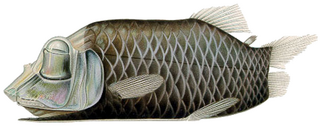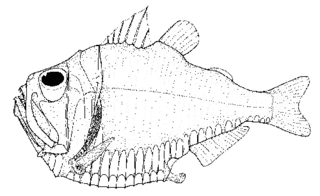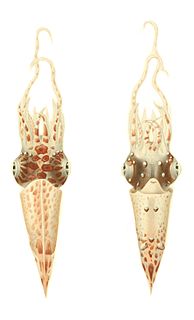
Deep-sea fish are fish that live in the darkness below the sunlit surface waters, that is below the epipelagic or photic zone of the sea. The lanternfish is, by far, the most common deep-sea fish. Other deep sea fishes include the flashlight fish, cookiecutter shark, bristlemouths, anglerfish, viperfish, and some species of eelpout.

Four-toothed whales or giant beaked whales are beaked whales in the genus Berardius. They include Arnoux's beaked whale in cold Southern Hemisphere waters, and Baird's beaked whale in the cold temperate waters of the North Pacific. A third species, Sato's beaked whale, was distinguished from B. bairdii in the 2010s.

Stomiiformes is an order of deep-sea ray-finned fishes of very diverse morphology. It includes, for example, dragonfishes, lightfishes, loosejaws, marine hatchetfishes and viperfishes. The order contains 4 families with more than 50 genera and at least 410 species. As usual for deep-sea fishes, there are few common names for species of the order, but the Stomiiformes as a whole are often called dragonfishes and allies or simply stomiiforms.

Marine hatchetfishes or deep-sea hatchetfishes are small deep-sea mesopelagic ray-finned fish of the stomiiform subfamily Sternoptychinae. They should not be confused with the freshwater hatchetfishes, which are not particularly closely related Teleostei in the characiform family Gasteropelecidae.

The marine hatchetfishes or deep-sea hatchetfishes as well as the related bottlelights, pearlsides and constellationfishes are small deep-sea ray-finned fish of the stomiiform family Sternoptychidae. They are not closely related to and should not be confused with the freshwater hatchetfishes, which are teleosts in the characiform family Gasteropelecidae. The Sternoptychidae have 10 genera and about 70 species altogether.

Polyipnus is a genus of oceanic ray-finned fish in the family Sternoptychidae. This is the largest genus of the marine hatchetfishes subfamily Sternoptychinae and indeed of the entire Sternoptychidae. It is not quite as apomorphic as their relatives; it may be that the genus is actually a paraphyletic assemblage of less advanced Sternoptychinae and would need to be split.

Sternoptyx is an oceanic ray-finned fish genus which belongs in the family Sternoptychidae. This is the type genus of the Sternoptychidae, as well as the marine hatchetfish subfamily Sternoptychinae.

Barreleyes, also known as spook fish, are small deep-sea argentiniform fish comprising the family Opisthoproctidae found in tropical-to-temperate waters of the Atlantic, Pacific, and Indian Oceans.

Pelagic fish live in the pelagic zone of ocean or lake waters—being neither close to the bottom nor near the shore—in contrast with demersal fish that do live on or near the bottom, and reef fish that are associated with coral reefs.

Argyropelecus gigas, the giant hatchetfish or greater silver hatchetfish, is a marine fish of the genus Argyropelecus. It is found in every ocean except the north Pacific in the mesopelagic zone of tropical and subtropical waters. "Giant" in relative terms only, this is the largest species of marine hatchetfishes, often exceeding 110 millimetres (4.3 in) standard length.

The giant oarfish is a species of oarfish of the family Regalecidae. It is an oceanodromous species with a worldwide distribution, excluding polar regions. Other common names include Pacific oarfish, king of herrings, ribbonfish, and streamer fish.

Pterygioteuthis giardi is a species of squid in the family Pyroteuthidae. It is known as the roundear enope squid. The specific name honors the French zoologist and marine biologist Alfred Mathieu Giard (1846-1908).

Argyropelecus aculeatus, the lovely hatchetfish or Atlantic silver hatchetfish, is a species of fish in the family Sternoptychidae. It may exceed 70 millimetres (2.8 in) standard length (SL). It lives in the mesopelagic zone of all oceans and performs diel vertical migration. A. aculeatus feeds on a large range of prey items; in the Gulf of Mexico ostracods and copepods dominated the diet of small individuals and euphausiids, molluscs, and fish the diet of larger ones. The silvery coloration and bioluminescence of the lovely hatchetfish allows it to hide from predators and prey in the down-welling light of the twilight zone.

Argyropelecus affinis is a species of ray-finned fish in the family Sternoptychidae, found in the tropical and subtropical Atlantic, Indian and Pacific Oceans. Common names for this fish include Pacific hatchetfish, deepsea hatchetfish and slender hatchetfish. It inhabits the mesopelagic zone and is either non-migratory or performs short daily vertical migrations.

Argyropelecus sladeni, or Sladen's hatchetfish, is a species of ray-finned fish in the family Sternoptychidae, found in the tropical and subtropical Atlantic, Indian and Pacific Oceans. This small fish lives in the mesopelagic zone by day and makes a daily vertical migration to the epipelagic zone at night.

Sternoptyx diaphana, the diaphanous hatchetfish, is a species of deep sea ray-finned fish in the family Sternoptychidae. It is the type species of the genus Sternoptyx, and was first described by the French naturalist Johann Hermann in Der Naturforscher 1781.
Polyipnus clarus, commonly known as the stareye hatchetfish or slope hatchetfish, is a species of ray-finned fish in the family Sternoptychidae. It occurs in deep water in the western Atlantic Ocean from the Gulf of Maine southward to the Caribbean Sea and the Gulf of Mexico. It most commonly occurs between 300 and 400 metres but can range from 40 and 830 metres.
Notoscopelus bolini is a species of lanternfish in the family Myctophidae. It is found in the North Atlantic Ocean and the Mediterranean Sea. It was first described in 1975 by the American ichthyologist Basil Nafpaktitis and named in honour of the American marine biologist Rolf Ling Bolin who had reviewed the genus in 1959.

Taractes rubescens, the pomfret, keeltail pomfret, knifetail pomfret or black pomfret, is a species of marine ray-finned fish, a pomfret of the family Bramidae. T. rubescens is closely related, and quite similar, to Taractes asper, but adults can most easily be distinguished by the bony keel present on the caudal peduncle. In fact, this bony keel is unique to Taractes rubescens and will distinguish it from all other bramids.
A micronekton is a group of organisms of 2 to 20 cm in size which are able to swim independently of ocean currents. The word 'nekton' is derived from the Greek νήκτον, translit. nekton, meaning "to swim", and was coined by Ernst Haeckel in 1890.

















